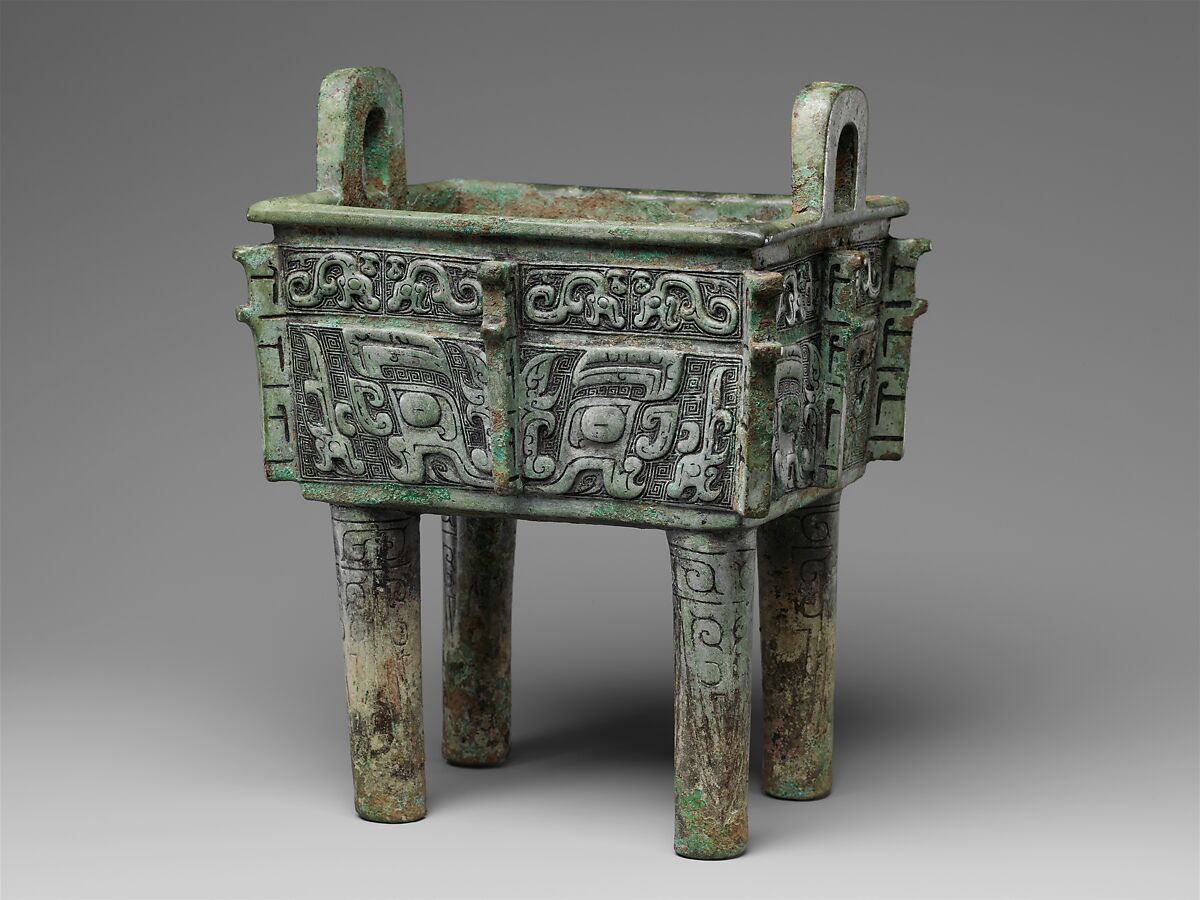Introduction
The Wine Container is one of the most iconic artifacts of the Shang Dynasty. During this era, bronze manufacturing technology existed in China in finished form. Artifact artisans were highly skilled, as evidenced by fine patterns, ornaments, and symbolic images on their products.
The Wine Container made during the late Shang Dynasty, circa 1600-1046 BC, is exhibited at the Art Institute of Chicago at Gallery 131. The Wine Container, along with other artifacts of the Shang Dynasty, is an iconic monument of the Bronze Age of Chinese history, a reflection of the political significance of power, social division, and the cultural importance of Feng Shui’s deep symbolism.
Wine Container
The complex bronze vessel is an iconic example of the achievements of the Bronze Age. Its image is presented in Appendix 2. The jug is shaped like a typical decanter with a thin neck and wide body, with a large lid, square shoulders, and four handles. Creatures molded into several relief levels are of the utmost importance.
The taotie mask is significant; the image is repeated along the jug. The hanging blades depict a cicada, which symbolizes a renewed life cycle. The neck is stylized with images of birds and dragons, separated by ribbons of scrolls. Two bull heads crown additional handles of the presented product.
The product’s shape is of applicable importance, while the composition using animals refers to strengthening the prestige of Feng Shui. Cattle symbolize strength and stamina, cicadas state for renewal, and dragons mean imperial power. The color of malachite green betrays the composition’s completeness, relief, and contrast.
Rectangular Cauldron
The bronze Rectangular Cauldron is an object of ritual significance. The image is presented in Appendix 3. An artifact created in the 12th-11th century BC is exhibited at The Met Museum in Gallery 207. This object has a pronounced stylized taotie mask, also seen on the Wine Container. There are two opposing profiles with curved horns on the item. The product is skillfully made, the shape reflects the ritual purpose, and the curved decorative elements along the edges testify to the craftsmanship of the creator. The legs of the product are decorated with spirals, and the color is again used to enhance the depth of the relief.
Goblet
A vessel of the late Shang Dynasty with a high degree of preservation is notable for its monumentality. The image is presented in Appendix 1. Art Institute of Chicago Gallery 131 features an artifact made between 1200 BC and 1046 BC. With artistic accuracy, animals are represented by two rows of masks. A bull’s head crowns a decorative handle. Serpentine creatures descend along the legs. According to the Feng Shui tradition, the image of snakes symbolizes wisdom and renewal. The creator uses composition to convey majesty, while color is necessary to emphasize the detail of images. The form is of practical meaning.
Historical, Social, and Cultural Context
The Wine Container and other bronze artifacts of the Shang Dynasty are evidence of the coincidence of handicraft trends and are of great historical importance. Firstly, the existence of the Shang Dynasty is known for certain due to these artifacts. From the social side of ancient Chinese society, high-quality bronze products demonstrate the existing class division, with luxury items referring to the upper class. In a cultural context, artifacts give an idea of the symbolism interpreted through the philosophy of Feng Shui.
For the Chinese ruling dynasty, luxurious bronze household items and ritual sacraments were symbols that supported political power, religious affiliation, and high social status. Product design, additional handles, practical shape, and stability elements are used to simplify the life of the ruling class. Symbols of bulls, dragons, and snakes are distinctive characteristics of political significance, necessary to emphasize rulers’ wisdom, divinity, and justice. The recurring element of a taotie mask has no authentic explanation but is supposedly a supreme symbol emphasizing the importance of rituals and sacrifices.
It is important to study household and ritual items from the Bronze Age, taking into account the historical context, as this provides a deeper understanding of the symbolism of the artifacts. The symbolism of Feng Shui helps determine the meaning of the images used and correlates them with the praising of the ruling dynasty. Luxurious items preserved from the Shang Dynasty allow modern scientists to reconstruct the social structure, appreciate the importance of ritual traditions, and determine the position of the ruler in the hierarchical structure.
Conclusion
The Wine Container and other artifacts provide valuable information about the Shang Dynasty. Artifacts of the Bronze Age emphasize the importance of the ruling power and its sacred meaning. Objects of ritual and domestic use are filled with symbolism and interpreted using the philosophy of Feng Shui. The study of bronze artifacts allows you to get an idea of life’s cultural, social, and political conditions in the period under review.
Bibliography
The Art Institute of Chicago. “Goblet (Jia)“. Artworks. Web.
The Art Institute of Chicago. “Wine Container“. Artworks. Web.
The Metropolitan Museum of Art. “Rectangular Cauldron (Fangding)“. Asian Art. Web.
Von Feigenblatt, Otto F. “The Significance of the Shang Period for the Contemporary Construction of Chinese Cultural Identity.” Journal of Business and Entrepreneurial Studies 4, no. 2 (2020): 309-318. Web.
Appendix 1. Goblet (Jia)

Appendix 2. Wine Container

Appendix 3. Rectangular Cauldron (Fangding)
